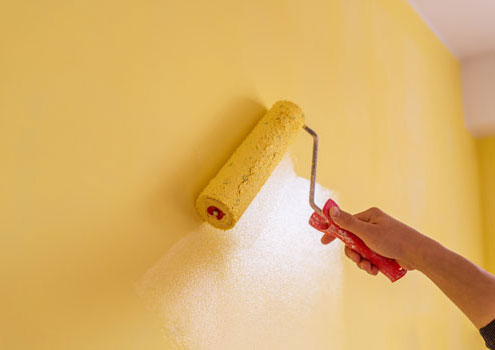Dispersion paints need binders

Over the past few decades, extensive knowledge regarding water-based paints has been amassed with a view to reducing their VOC content and, at the same time, improving their environmental compatibility. However, calls for more environmentally friendly paint systems are growing ever louder – from consumers and industry alike.
Interior and exterior wall paints are produced from a complex mixture, comprising mainly polymer binders, pigments, fillers, additives and water (the solvent). The binders in this mixture are the film formers in the coating systems. They account for up to 30% of the total mixture and therefore influence important properties, such as adhesive capacity, resistance to cracking and flaking, and the processing properties of the wall paint. Nowadays, commercial binders are made primarily from polymers or copolymers of styrene, butadiene, various acrylates and vinyl acetate – all of which are synthesized from fossil raw materials. Various research approaches have been pursued to replace these petroleum-based binders with more sustainable options, without compromising the qualitative and performance properties of the dispersion paint. However, little progress has been made – until now.
The “DisPro” project aims to provide the market with more sustainable alternatives by swapping petrochemical polymers in aqueous dispersion paints with plant-based raw materials.
Bio-based binder systems from plant-based raw materials
One possible bio-based alternative is to use biopolymers produced from renewable raw materials or residues as binders. This includes biopolymers from starch, protein or lignin.
Plant proteins have a broad range of different functional properties and, under certain conditions, these can produce foams or gels, for example. Moreover, their complex structure and modifiability make them potential candidates to act as binders and film formers, thereby replacing environmentally harmful acrylates. However, it has thus far not been possible to develop a consumer-friendly “1 bucket” solution that allows easy workability of a protein-based dispersion paint. Previous application solutions often require various components to be agitated and mixed immediately prior to use by the end consumer, which is a cumbersome, complex and error-prone process.
“DisPro” aims to develop a novel, protein-based binder for dispersion paints to help reduce the proportion of petroleum-based material components in the finished product. Commercially available plant-based raw materials will be used as the basis so that the results can be quickly transferred to industry applications.
Promising project results and plans for further development
To establish a solid foundation of data, the project began with protein screening. The proteins were thoroughly analyzed with respect to dry matter, protein content, molecular weight distribution, solubility, foaming behavior and film-forming properties (pore size, flexibility, color, adhesion, etc.). In the next step, protein dispersions were prepared to determine the influence of different protein concentrations and process parameters (e.g. temperature, pH) on the viscosity and stability of the dispersions. The long-term stability of the developed color formulations was further investigated in storage tests.
Pea and soy proteins showed the best results in the screening and were therefore used for further optimization. The functional properties of the protein preparations were successfully improved for specific applications by physical, chemical or enzymatic modification. The modified products were functionally characterized in application-oriented studies (e.g. film formation tests, abrasion tests). It was found that the water resistance and adhesion of the protein products in particular could be significantly optimized by modification.
In a first industrial scale-up, two protein products were successfully used in dispersion paints. The protein products easily replaced 50% of the conventional acrylates without any changes to the formulation. Future cooperation will be aimed at substituting the entire acrylate content.
Based on the promising results of the research on modified protein products, two further projects have already been initiated at the Fraunhofer IVV to develop plant-based protein products for the wood/furniture, corrugated board and detergent industries:
- The project ProWellHo is aimed at the development of a bio-based protein adhesive for use in corrugated board and wood products.
- The project ProColor aims to develop a protein-based color transfer inhibitor for color detergents.
Project term: |
2021 to 2024 |
Project management |
Project Management Jülich GmbH (PTJ) |
Related projects: |
 Fraunhofer Institute for Process Engineering and Packaging IVV
Fraunhofer Institute for Process Engineering and Packaging IVV